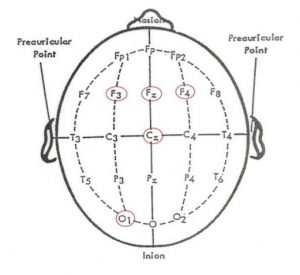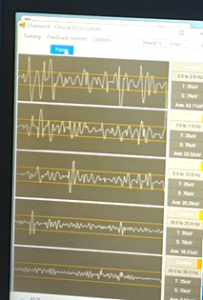Wouldn’t it be easier to treat someone’s neurological problem by analyzing how their brain functions? Learn more about “Brain Mapping”, how a powerful tool called Clinical Q works to collect brain data, and how it is relevant in therapy.
Treating the Neurology
Clinical Q Assessment Method
Can you treat the symptoms of a problem without first knowing how the brain is functioning? Would you see a doctor that does not use a stethoscope? Probably not. As a Neurotherapies, I believe a validated methodology of gathering empirical data is a necessary means to inform the treatment direction. The most effective way to gather live accurate empirical data of a person seeking therapy is by conducting a Quantitative Electroencephalogram (QEEG) or “Brain Mapping” and then do an analysis of the various brainwaves (Beta, SMR, Alpha, Theta and Delta) – analyzing the amplitude and connectivity before a treatment protocol is delivered. In EMCC, we gather this data through the clinical assessment tool known as Clinical Q.Developed by Dr Paul Swingle, it is a powerful assessment tool that uses actual Clinical Client Database instead of a General non-client Normative Database. This means, the Clinical Q comparisons are derived from clients who are actually in treatment and have the brainwave patterns for depression, anxiety, trauma etc. These clinical clients’ brainwaves patterns form the clinical database comparisons, and over time, the therapist can treat and track the progress of treatment.To better understand what Clinical Q is, we need to go deeper and compare it with QEEG (Quantitative Electroencephalogram) – both are methods in conducting a detailed “brain mapping”. The brain mapping is a process of detecting if any area of the brain is dysfunctional or dysregulated. An inactive or overactive brainwave are indicative markers of a symptoms.
So, what is the difference between Clinical Q and QEEG.
1. Clinical Q vs. QEEG
Clinical Q and a full QEEG brain mapping is the process of collecting Electroencephalogram (EEG) data and then have the data analysed to derive at a clinical assessment and treatment protocol. Electroencephalography (EEG) is the measurement of electrical patterns at the surface of the scalp which reflects cortical activity, and are commonly referred to as “brainwaves”. Quantitative EEG (QEEG) is the analysis of the digitized EEG, or commonly known as “Brain Mapping”. The Clinical Q is different from a full QEEG “brain mapping” in several ways. Firstly, the Clinical Q uses just one channel to collect 6 minutes of amplitude data from 5 sites whereas a QEEG requires 19 sites of amplitude data.
Secondly, the results of a Clinical Q are compared to a clinical database and not general population norms, as are used in QEEGs. This is the uniqueness of Clinical Q as it gives the Neurotherapist a more specific marker of a specific symptom and brain activity or inactivity. In Dr. Swingle’s research, he found 23 EEG values, ratios, or totals to be statistically significant markers for particular symptoms that are used as the basis of the Clinical Q analysis.
A full QEEG do yield a rich set of data from 19 sites. The QEEG data acquisition is extensive, expensive and time consuming – taking up to two hours to gather data from all 19 sites and another four or more hours to analyze all the data. According to Dr Swingle, the Clinical Q can be enough for 95% of the conditions seeking treatment as it is designed for clinical interventions.
To summarize, Clinical Q requires a significantly shorter time, data collected are specific to the needs in a clinical counselling setting and offers a 85% in cost savings as compared to a full QEEG brain mapping.
2. How is the Clinical Q Assessment conducted
The tools required to conduct a Clinical Q assessment is a Brain trainer system, the software and sensors and electrodes to collate the data from the scalp. The five sites to collect data are CZ, O1, F3, F4, FZ. The figure below are the five sites where the electrodes are placed.


The whole data collection only takes six minutes, with occasions when your eyes are either kept opened or closed. To analyze the changes in the brainwaves while completing a cognitive task, either a reading or arithmetic task will also be given. The data analysis in the changes in the brainwaves amplitude will give a good feedback into the brain amplitude.
3. What brainwaves frequencies are measured and collected
The brain is the core of all human experience. All thoughts, emotions and behavior’s is the communication between neurons within our brains.
Brainwaves are produced by electrical pulses from neurons communicating with each other. As mentioned, the brain activity is detected using sensors placed on the scalp. The brain activity is divided into bandwidths to describe their functions, but are best thought of as a continuous spectrum of consciousness; from slow, loud and functional – to fast, subtle, and complex.

 Reading of a client’s brainwave frequencies
Reading of a client’s brainwave frequencies
Clinical Q assessment measures the five sites for the Beta, SMR, Alpha, Theta and Delta amplitudes, just like the QEEG. The results are then analysed and the results will be used in the assessment.
4. Describing the Results
A Clinical Q interpretation is somewhat similar to Cognitive Behaviour Therapy as in the symptom is reframed and a cognitive restructuring is offered from the perspective of an over-functioning or an under-functioning in the electrophysiological profile. The client is offered options to address the neurology – the way that the brain can be retrained and symptoms managed through the various treatment options that EMCC offers, namely Psychotherapy, Neurotherapy, Clinical hypnosis or a combination of all three. In the spirit of Dr Swingle, therapy about “treating the neurology and not the label” of depression, anxiety, stress or trauma.


